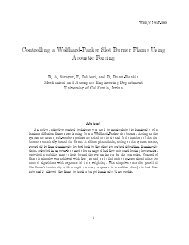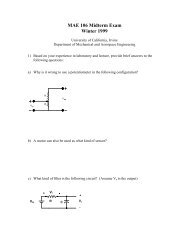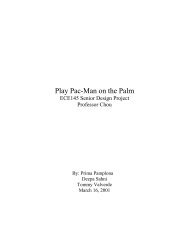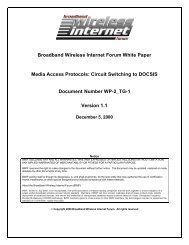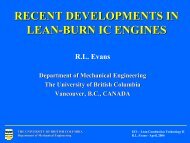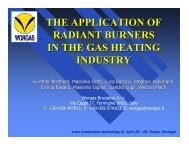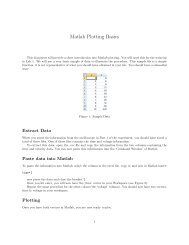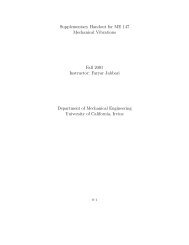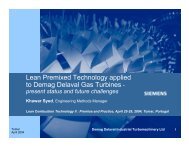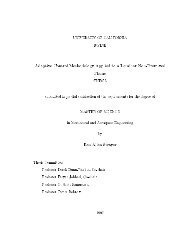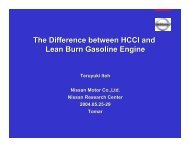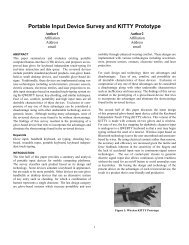The Influences of Preheat Temperature and Mixture Compositions ...
The Influences of Preheat Temperature and Mixture Compositions ...
The Influences of Preheat Temperature and Mixture Compositions ...
Create successful ePaper yourself
Turn your PDF publications into a flip-book with our unique Google optimized e-Paper software.
Lean Combustion Conference II<br />
April 25-29, 2004, Tomar, Portugal<br />
<strong>The</strong> <strong>Influences</strong> <strong>of</strong> <strong>Mixture</strong> Composition<br />
<strong>and</strong> <strong>Preheat</strong> <strong>Temperature</strong> on<br />
Combustion Regime<br />
ChulJu AHN*, Fumiteru AKAMATSU*,<br />
Masashi KATSUKI *, Akio KITAJIMA **<br />
*Department <strong>of</strong> Mechanical Engineering, Osaka University, Japan<br />
** Combustion Reaction Control Research Group, Institute for Energy<br />
Utilization, National Institute <strong>of</strong> Advanced Industrial <strong>and</strong> Science ce Technology,<br />
Japan
Background(1)<br />
<br />
Energy Efficiency V.S. NOx Emission<br />
Combustion air preheating by regenerater<br />
<br />
Emerging new combustion technology<br />
⇒ called mild combustion, flameless oxidation<br />
or highly preheated air combustion<br />
Advanced furnace technology resolving the dilemma<br />
<strong>of</strong> thermal efficiency <strong>and</strong> nitric oxide emission<br />
has been developed
Highly preheated air combustion<br />
air<br />
fuel<br />
spark plug<br />
open<br />
open<br />
pilot burner A pilot burner B<br />
on<br />
flow <strong>and</strong> combustion<br />
<strong>of</strong>f<br />
close<br />
close<br />
air<br />
fuel<br />
spark plug<br />
heat transfer<br />
fuel<br />
open<br />
slab<br />
close<br />
fuel<br />
burner A<br />
burner B<br />
4-way switching valve<br />
insulation<br />
ceramic honeycomb<br />
air<br />
open<br />
G<br />
gate valve<br />
open<br />
exhaust gas
Variation <strong>of</strong> NOx Emissions Level with Air <strong>Temperature</strong><br />
200<br />
NOx [ppm] at 0 % O2<br />
100<br />
Conventional<br />
Air Staging Burner<br />
Excess Air : 20 %<br />
HiPAC Burner<br />
Excess Air : 30 %<br />
0<br />
0 200 400 600 800 1000 1200<br />
Air <strong>Temperature</strong> [℃]
Flammable domain <strong>of</strong> mixture<br />
♦ Flammable domain as a function <strong>of</strong> T mix , Y O2 , <strong>and</strong> φ<br />
Present work<br />
T mix = 1173K<br />
T mix<br />
Low O 2 O 2 21%<br />
φ φ st<br />
300K<br />
Rich Lean<br />
YO 2<br />
Conventional region<br />
<strong>of</strong> study on premixed<br />
turbulent combustion
Background(2)<br />
<br />
Principal feature <strong>of</strong> mild combustion<br />
Mixing <strong>of</strong> fuel <strong>and</strong> air or air/fuel mixture with large<br />
amounts <strong>of</strong> exhaust gas in the furnace by high speed<br />
ejection <strong>of</strong> combustion air (Internal EGR)<br />
Formation <strong>of</strong> lean diluted mixture with<br />
burned product before combustion reaction<br />
Decrease <strong>of</strong> thermal NOx formation
Far-lifted jet flame<br />
Oxygen concentration in the co-flow : 21%<br />
Fuel : CH4, Nozzle diameter :0.4mm<br />
V jet,fuel : 80m/s<br />
V jet,fuel :160m/s<br />
1235K 1194K 1165K<br />
1337 K 1297 K
Direct photograph <strong>of</strong> flames<br />
1400<br />
Air temperature K<br />
1300<br />
1200<br />
1100<br />
900<br />
200 ~100<br />
90 ~40<br />
Vf<br />
Va1<br />
Va0<br />
<strong>Preheat</strong>ed Air<br />
Fuel<br />
Nozzle<br />
Fuel<br />
600<br />
21 17 15 11 8 5<br />
O2 2mole fraction %
Autoignition <strong>and</strong> blow-<strong>of</strong>f temperatures<br />
<strong>of</strong> propane in air <strong>and</strong> air diluted with nitrogen<br />
1800<br />
Air temperature K<br />
1600<br />
1400<br />
1200<br />
1000<br />
800<br />
600<br />
400<br />
Pa = 0.12<br />
Re: air = 1.2 × 10<br />
Re: fuel = 4.2 × 10<br />
×<br />
×<br />
×<br />
○<br />
■<br />
×<br />
Flammable region<br />
×<br />
No flame region<br />
×<br />
Autoignition Boundary<br />
Stable Boundary<br />
Auto-ignition point<br />
Non Auto-ignition point<br />
Unstable Point (CO>100 ppm)<br />
× × × ×<br />
φ=1<br />
× × 0<br />
200<br />
20<br />
15 10<br />
5<br />
O 2<br />
concentration %
Objective(1)<br />
To observe the change <strong>of</strong> combustion regime <strong>of</strong><br />
turbulent premixed flames with various mixture<br />
composition <strong>and</strong> preheat temperature
Experimental apparatus<br />
Air +N 2<br />
H 2<br />
O 2<br />
fuel<br />
T1<br />
Q T =Q a +Q N2<br />
Nozzle mixing<br />
Duct<br />
T2
Flammability limit<br />
φ equivalence ratio<br />
0.2<br />
0.3<br />
0.4<br />
0.5<br />
0.6<br />
0.7<br />
0.8<br />
20 18 16 14 12 10 8 6<br />
O 2 co ncentratio n %<br />
C H 4 5 7 3 K<br />
C H 4 7 7 3 K<br />
C H 4 9 7 3 K<br />
C H 4 1 0 7 3 K<br />
C H 4 1 1 7 3 K
Flame temperature at extinction<br />
Y CH4<br />
%<br />
5.0<br />
4.5<br />
4.0<br />
3.5<br />
3.0<br />
2.5<br />
Tad<br />
2.0<br />
500 600 700 800 900 100011001200<br />
<strong>Mixture</strong> temperature K<br />
2000<br />
1800<br />
1600<br />
1400<br />
1200<br />
1000<br />
800<br />
600<br />
400<br />
Adiabatic flame temperature K
Experimental condition (Tu=1173K)<br />
Q ox (L/min) Q CH4 (L/min) O 2 (%) T ad (K) S L (m/s)<br />
F3Hox 65 3.15 19.4 2112 3.934<br />
F3Mox 65 3.15 13.0 2118 3.220<br />
F2Hox 65 2.40 19.4 1923 3.003<br />
F2Mox 65 2.40 13.0 1927 2.625<br />
F2Lox 65 2.40 7.4 1917 1.555<br />
F1Hox 65 1.68 19.4 1719 1.952<br />
F1Mox 65 1.68 13.0 1721 1.806<br />
F1Lox 65 1.68 7.4 1724 1.322<br />
Since Q ox was fixed as 65, turbulence level is<br />
almost same at each condition
Approach<br />
To investigate flame structure <strong>of</strong> turbulent<br />
premixed flames with high preheat temperature<br />
(1173K)<br />
Flame structure<br />
→ Flame visualization by OH-LIPF<br />
→ <strong>Temperature</strong> measurement by <strong>The</strong>rmocouple<br />
Mixing time (turbulent time) estimation<br />
→ 1-D LDV :Estimation by calculating auto-correlation coefficient using<br />
slot-method<br />
<br />
Chemical time estimation<br />
→Laminar flame calculation <strong>of</strong> S L , δ th by PREMIX with GRI-Mech3.0
Methane flames<br />
<strong>Mixture</strong> temperature : 1173K<br />
O2<br />
7.4%<br />
φ 1.0 φ 0.9 φ 0.8 φ 0.7<br />
O2<br />
13.0%<br />
φ 0.7 φ 0.6 φ 0.5 φ 0.4<br />
O2<br />
19.4%<br />
φ 0.6 φ 0.5 φ 0.4 φ 0.3
Instantaneous OH-LIPF images(1)<br />
F3Hox<br />
F3Mox<br />
Image<br />
region<br />
-18-16-14-12-10 -8 -6 -4 -2 0 2 4 6 -18-16-14-12-10 -8 -6 -4 -2 0 2 4 6
Instantaneous OH-LIPF images(2)<br />
F2Hox F2Mox F2Lox<br />
-18-16-14-12-10 -8 -6 -4 -2 0 2 4 6 -18-16-14-12-10 -8 -6 -4 -2 0 2 4 6 -18-16-14-12-10 -8 -6 -4 -2 0 2 4 6
Instantaneous OH-LIPF images(3)<br />
F1Hox F1Mox F1Lox<br />
-18-16-14-12-10 -8 -6 -4 -2 0 2 4 6 -18-16-14-12-10 -8 -6 -4 -2 0 2 4 6 -18-16-14-12-10 -8 -6 -4 -2 0 2 4 6
OH-LIPF images <strong>and</strong> PDF <strong>of</strong> temperature<br />
Ka=0.44<br />
Ka=0.65<br />
Ka= (δ F /η) 2<br />
(a) F3Hox<br />
(b) F3Mox<br />
-11 -9 -7 -5 -3 -1 1 3 5 7 9 11<br />
125<br />
100<br />
75<br />
50<br />
25<br />
a.u.<br />
T(F3Hox)<br />
T(F3Mox)<br />
2000<br />
1600<br />
1200<br />
800<br />
PDF %<br />
2000<br />
1600<br />
1200<br />
800<br />
PDF %<br />
0 2 4 6 8 10<br />
Time ms<br />
R=3.5mm<br />
6<br />
4<br />
2<br />
0<br />
800 1000 1200 1400 1600 1800 2000<br />
<strong>Temperature</strong> K<br />
8<br />
6<br />
4<br />
2<br />
0<br />
0 2 4 6 8 10<br />
Time ms<br />
R=4mm<br />
800 1000 1200 1400 1600 1800 2000<br />
<strong>Temperature</strong> K
OH-LIPF images <strong>and</strong> PDF <strong>of</strong> temperature<br />
Ka=0.74<br />
Ka= (δ F /η) 2<br />
Ka=0.97<br />
Ka=2.76<br />
(a) F2Hox<br />
(a) F2Mox<br />
(a) F2Lox<br />
-4 -2 0 2 4 6 8 10 12 14 16 18<br />
R mm<br />
60<br />
50<br />
40<br />
30<br />
20<br />
10<br />
a.u.<br />
18<br />
16<br />
14<br />
12<br />
10<br />
8<br />
6<br />
4<br />
2<br />
Z mm<br />
T(F2Hox)<br />
T(F2Mox)<br />
T(F2Lox)<br />
2000<br />
1600<br />
1200<br />
800<br />
8<br />
PDF %<br />
6<br />
4<br />
2<br />
0<br />
2000<br />
1600<br />
1200<br />
800<br />
4<br />
2<br />
0<br />
PDF %6<br />
0 2 4 6 8 10<br />
Time ms<br />
R=6mm<br />
800 1000 1200 1400 1600 1800 2000<br />
<strong>Temperature</strong> K<br />
0 2 4 6 8 10<br />
Time ms<br />
R=6mm<br />
800 1000 1200 1400 1600 1800 2000<br />
<strong>Temperature</strong> K<br />
2000<br />
1600<br />
1200<br />
800<br />
0 2 4 6 8 10<br />
8<br />
6 R=7.5mm Time ms<br />
4<br />
2<br />
0<br />
8800 1000 1200 1400 1600 1800 2000<br />
PDF %<br />
<strong>Temperature</strong> K
Calculated chemical properties in experimental<br />
conditions (T u =1173K)<br />
F3Hox F3Mox F2Hox F2Mox F2Lox F1Hox F1Mox F1Lox<br />
T AD K( ± 5K ) 2120 1920 1720<br />
T i K( ± 5K ) 1550 1520 1420<br />
T OH K( ± 5K ) 1780 1600 1540<br />
Density ratio γ 1.81 1.64 1.47<br />
Density ratio γ OH<br />
1.52 1.36 1.31<br />
O 2 %<br />
Equivalence ratio<br />
S L m/s<br />
S OH m/s<br />
δ th µm<br />
δ OH µm<br />
τ F =δ th /S L µs<br />
τ OH =δ OH /S OH µs<br />
19.4 13.0 19.4 13.0 7.4 19.4 13.0 7.4<br />
0.5 0.75 0.38 0.57 1.0 0.27 0.4 0.7<br />
3.934 3.220 3.003 2.625 1.555 1.952 1.806 1.322<br />
6.1 5.0 4.31 3.78 2.25 2.56 2.38 1.81<br />
363 423 430 478 687 583 614 748<br />
222 236 254 264 324 316 322 355<br />
92 131 143 182 442 299 340 566<br />
36 47 59 67 144 123 135 196
Flame classification by Borghi<br />
Re L = u’L/ν<br />
u’/S L<br />
Stirred<br />
reactor<br />
<br />
DRZ<br />
u'/<br />
S L<br />
Ka= (δ F /η) 2<br />
Da<br />
τ<br />
f<br />
= =<br />
τ<br />
c<br />
LE/ u'<br />
δ / S<br />
F<br />
L<br />
L<br />
δ<br />
Da<br />
λ<br />
=<br />
λ / u'<br />
δ /<br />
S L
Flame classification diagram proposed by Peters<br />
Hatched region is the area observed as thin reaction zone by others<br />
at room temperature condition.<br />
u’/ S L<br />
100<br />
10<br />
1<br />
Broken reaction zone<br />
Thin reaction zone<br />
Ka=100<br />
Wrinkled laminar flame<br />
Ka=10<br />
Ka=3<br />
Ka=1<br />
Corrugated flamelet<br />
0.1<br />
0.1 1 10 100 1000<br />
F3Hox<br />
F3Mox<br />
F2Hox<br />
F2Mox<br />
F2Lox<br />
F1Hox<br />
Mansour (1998)<br />
φ=1.0, fuel(CH4)<br />
T u = 300K, O 2 21%<br />
Ka = 17<br />
Thin reaction zone<br />
F2 7.4% Flame<br />
φ=1.0, fuel(CH4)<br />
T u = 1173, O 2 7.4%<br />
Ka = 2.76<br />
Broken reaction zone<br />
L E / δ F
⎛<br />
Ka C L<br />
F<br />
=<br />
m⎜<br />
⎝ δ<br />
C<br />
τ t<br />
τ<br />
m<br />
th<br />
⎞<br />
⎟<br />
⎠<br />
05<br />
= ( S δ / 15ν<br />
) . ≅1<br />
m L th u<br />
= L / u'<br />
f<br />
= δ / S<br />
F th L<br />
L m<br />
Dimensionless number for flame classification by<br />
≡ ε<br />
12 / 32 /<br />
τ F<br />
Da<br />
F<br />
Chen(1)<br />
τ L u<br />
t f<br />
= = ⎛ ⎝ ⎜ / ' ⎞<br />
⎟<br />
τ δ / S ⎠<br />
F<br />
th<br />
L<br />
(Turbulent)<br />
<strong>Preheat</strong> zone<br />
−1<br />
δ th<br />
Re<br />
= Lu' f<br />
ν u<br />
Burnt gas<br />
Mixing length scale:<br />
maximum distance that<br />
preheated fluid can be<br />
transported ahead <strong>of</strong> the flame<br />
L m<br />
<strong>Preheat</strong>ed material<br />
Reaction zone
Regime Diagram by Chen et al. (1)<br />
100<br />
10<br />
u' / S L<br />
1<br />
0.1<br />
Re=100<br />
5<br />
well stirred<br />
flame front<br />
Re=1<br />
laminar flow<br />
distributed flame front<br />
4<br />
2<br />
3<br />
Da F<br />
=1<br />
turbulent<br />
flame front<br />
Ka F<br />
=1 or L m<br />
=δ th<br />
complex strain flame front<br />
η u<br />
=δ th<br />
wrinkled laminar flamelets<br />
1<br />
Chen<br />
Mansour<br />
Dinkelacker<br />
Buschmann<br />
Present data<br />
0.01<br />
0.1 1 10 100<br />
L f<br />
/ δ th
What is difference<br />
Ka F<br />
Da F<br />
L m<br />
L m,OH<br />
L m /δ th<br />
mm<br />
mm<br />
Present flames(1173K)<br />
L m,OH /δ OH<br />
F3Hox F3Mox F2Hox F2Mox F2Lox F1Hox F1Mox F1Lox<br />
0.74 1.06 1.15 1.47 3.56 2.41 2.74 4.56<br />
5.41 3.80 3.49 2.74 1.13 1.67 1.47 0.88<br />
0.35 0.6 0.68 0.97 3.68 2.04 2.48 5.33<br />
0.09 0.13 0.18 0.23 0.68 0.54 0.62 1.09<br />
0.97 1.41 1.58 2.04 5.35 3.51 4.04 7.13<br />
0.39 0.54 0.71 0.88 2.11 1.72 1.93 3.06<br />
Flames <strong>of</strong> Chen et al.(300K)<br />
MM1 MM2 ML3 MM3 MH3 MM4<br />
Ka F<br />
Da F<br />
L m<br />
L m,OH<br />
L m /δ th<br />
L m,OH /δ OH<br />
mm<br />
mm<br />
0.86 1.26 1.25 2.58 3.76 3.83<br />
7.5 5.1 4.0 2.5 2.0 1.7<br />
0.43 0.76 1.05 2.22 3.23 3.85<br />
0.0102 0.0194 0.0265 0.0558 0.0812 0.0897<br />
0.98 1.51 1.65 3.46 5.04 5.20<br />
0.054 0.091 0.107 0.226 0.329 0.346
Exp<strong>and</strong>ing for the scalar such as OH, CH(2)<br />
Ka<br />
ψ<br />
= ⎛ ⎝ ⎜ ⎜<br />
L m , ψ<br />
δ ψ<br />
⎞<br />
⎟<br />
⎠<br />
Da<br />
ψ<br />
τ<br />
L<br />
/ u'<br />
t f<br />
= = ⎛ τψ ⎝ ⎜ δψ / Sψ<br />
⎞<br />
⎟<br />
⎠<br />
−1<br />
Re<br />
= Lu' f<br />
ν u<br />
τ t<br />
τ<br />
= L / u'<br />
f<br />
= δ / S<br />
ψ ψ ψ<br />
/ /<br />
L m, ψ<br />
≡ ε<br />
12 32<br />
τψ<br />
(Turbulent)<br />
<strong>Preheat</strong> zone<br />
δ ψ<br />
Burnt gas<br />
Mixing length scale for scalar:<br />
maximum distance that<br />
scalar can be transported<br />
ahead <strong>of</strong> the reaction zone<br />
L m,ψ<br />
Reaction zone<br />
L<br />
1/ 2 3/<br />
2
Definition <strong>of</strong> flame thickness<br />
<strong>Temperature</strong> K<br />
<strong>Temperature</strong><br />
CH<br />
OH<br />
δ th<br />
Y ψ<br />
δ<br />
th<br />
=<br />
Tad<br />
− Tu<br />
( ∂T<br />
/ ∂x)| max<br />
<strong>Temperature</strong> K<br />
T OH<br />
x coordinate mm<br />
<strong>Temperature</strong><br />
OH<br />
δ OH<br />
Y ΟΗ<br />
T<br />
S<br />
δ<br />
OH<br />
OH<br />
OH<br />
YOH<br />
= T<br />
⎛ ⎝ ⎜ ∂ ⎞<br />
⎟<br />
∂x<br />
⎠<br />
max<br />
TOH<br />
= ⎛ S<br />
⎝ ⎜ ⎞<br />
⎟ =γ<br />
T ⎠<br />
=<br />
u<br />
( YOH<br />
|<br />
max<br />
)<br />
( ∂Y<br />
/ ∂x)|<br />
OH<br />
S<br />
L OH L<br />
max<br />
x coordinate mm
Modified Diagram by Ka ψ , Da ψ (300K)<br />
Ka ψ =1, Da ψ =1 for methane (300K, φ=1)<br />
1000<br />
u' / S L<br />
100<br />
10<br />
1<br />
0.1<br />
Re=100<br />
Re=10<br />
Re=1<br />
Quenching<br />
Da F<br />
=1<br />
0.01<br />
0.1 1 10 100<br />
L f<br />
/ δ th<br />
4<br />
3<br />
Da CH<br />
=1<br />
Da OH<br />
=1<br />
Ka CH<br />
=1 or L m,CH<br />
=δ CH<br />
Ka F<br />
=1 or L m<br />
=δ th<br />
Ka OH<br />
=1 or L m,OH<br />
=δ OH<br />
η u<br />
=δ th<br />
Distributed flame front<br />
(with broken reaction zones)<br />
Turbulent flame front<br />
(with thin reaction zone)<br />
Chen<br />
Mansour<br />
Dinkelacker<br />
Buschmann
Changes <strong>of</strong> critical dimensionless number with<br />
increasing T u (φ=1.0, CH4, 1atm)<br />
Ka F,OH_crit<br />
30<br />
25<br />
20<br />
15<br />
10<br />
5<br />
Ka<br />
=<br />
C<br />
F, ψ_<br />
crit m<br />
32 /<br />
ψ<br />
0.5<br />
0.4<br />
0.3<br />
0.2<br />
0.1<br />
0<br />
0.0<br />
400 600 800 1000<br />
<strong>Mixture</strong> <strong>Temperature</strong> T u<br />
K<br />
1<br />
γ<br />
⎛ δ<br />
ψ<br />
Da F , ψ _ crit<br />
= ⎜<br />
γ<br />
ψ ⎝ δth<br />
⎛ δ<br />
⎜<br />
⎝ δ<br />
⎞<br />
⎟<br />
⎠<br />
th<br />
ψ<br />
⎞<br />
⎟<br />
⎠<br />
Da F,OH_crit<br />
T AD<br />
, T OH<br />
K<br />
2800<br />
2600<br />
2400<br />
2200<br />
2000<br />
1800<br />
1600<br />
1400<br />
1200<br />
1000<br />
density ratio γ, γ OH<br />
8<br />
7<br />
6<br />
5<br />
4<br />
3<br />
2<br />
T AD<br />
T OH<br />
S OH<br />
S L<br />
400 600 800 1000<br />
<strong>Mixture</strong> <strong>Temperature</strong><br />
u<br />
TK<br />
δ<br />
δ<br />
γ ΟΗ<br />
th<br />
OH<br />
γ<br />
δ th / δ OH<br />
TAD<br />
− Tu<br />
=<br />
( ∂T<br />
/ ∂x)| max<br />
YOH<br />
|<br />
max<br />
=<br />
( ∂Y<br />
/ ∂x)|<br />
OH<br />
max<br />
400 600 800 1000<br />
<strong>Mixture</strong> <strong>Temperature</strong><br />
u<br />
TK<br />
20<br />
18<br />
16<br />
14<br />
12<br />
10<br />
8<br />
6<br />
4<br />
2<br />
0<br />
8<br />
7<br />
6<br />
5<br />
4<br />
3<br />
2<br />
1<br />
0<br />
S L<br />
, S OH<br />
m/s<br />
scale ratio δ th<br />
/δ OH
Modified Diagram by Ka ψ , Da ψ (1173K)<br />
Ka ψ =1, Da ψ =1 for for present F3Hox<br />
1000<br />
u' / S L<br />
100<br />
10<br />
1<br />
Re=100<br />
Re=10<br />
Re=1<br />
Quenching<br />
Da F<br />
=1<br />
4<br />
3<br />
Da CH<br />
=1<br />
Da OH<br />
=1<br />
Ka CH<br />
=1 or L m,CH<br />
=δ CH<br />
Ka F<br />
=1 or L m<br />
=δ th<br />
Ka OH<br />
=1 or L m,OH<br />
=δ OH<br />
Distributed flame front<br />
(with broken reaction zones)<br />
Turbulent flame front<br />
(with thin reaction zone)<br />
0.1<br />
η u<br />
=δ th<br />
0.01<br />
0.1 1 10 100<br />
Present data<br />
L f<br />
/ δ th
Summary<br />
• Extinction limit is mainly affected by mole fraction <strong>of</strong><br />
fuel (thus, flame temperature) <strong>and</strong> is less affected by O2<br />
concentration in premixed turbulent combustion<br />
• <strong>The</strong> criterion between flamelet regime <strong>and</strong> broken<br />
reaction zones changes depending on initial condition <strong>of</strong><br />
mixture such as mole fractions <strong>of</strong> fuel, oxygen <strong>and</strong> initial<br />
temperature.<br />
• Mild combustion in premixed type is observed in high<br />
temperature <strong>and</strong> low oxygen concentration with the<br />
characters <strong>of</strong> small temperature fluctuations, low sound<br />
emission, relatively distributed reaction zone.
Thank you.



